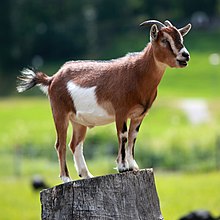Goat milk
| Domestic goat Temporal range: .01–0 Ma Neolithic – Recent |
|
|---|---|
 |
|
| A pygmy goat on a stump. | |
|
Domesticated
|
|
| Scientific classification | |
| Kingdom: | Animalia |
| Phylum: | Chordata |
| Class: | Mammalia |
| Order: | Artiodactyla |
| Family: | Bovidae |
| Subfamily: | Caprinae |
| Genus: | Capra |
| Species: | C. aegagrus |
| Subspecies: | C. a. hircus |
| Trinomial name | |
|
Capra aegagrus hircus (Linnaeus, 1758) |
|
| Synonyms | |
|
Capra hircus |
|
Capra hircus
The domestic goat (Capra aegagrus hircus) is a subspecies of goat domesticated from the wild goat of southwest Asia and Eastern Europe.
The goat is a member of the family Bovidae and is closely related to the sheep as both are in the goat-antelope subfamily Caprinae. There are over 300 distinct breeds of goat. Goats are one of the oldest domesticated species, and have been used for their milk, meat, hair, and skins over much of the world. In 2011, there were more than 924 million live goats around the globe, according to the UN Food and Agriculture Organization.
Female goats are referred to as "does" or "nannies;" intact males are called "bucks" or "billies;" and juveniles of both sexes are called "kids". Castrated males are called "wethers". Goat meat from younger animals is called "kid" or (Spanish), while meat from older animals is known simply as "goat" or sometimes called , or in some areas "mutton" (which more often refers to adult sheep meat).
The Modern English word goat comes from Old English gāt "she-goat, goat in general", which in turn derives from Proto-Germanic *gaitaz (cf. Dutch/Icelandic geit, German Geiß, and Gothic gaits), ultimately from Proto-Indo-European *ǵʰaidos meaning "young goat" (cf. Latin haedus "kid"), itself perhaps from a root meaning "jump" (assuming that Old Church Slavonic zajęcǐ "hare", Sanskrit jihīte "he moves" are related). To refer to the male, Old English used bucca (giving modern buck) until ousted by hegote, hegoote in the late 12th century. Nanny goat (females) originated in the 18th century and billy goat (for males) in the 19th.
...
Wikipedia
